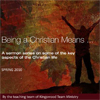Richard Rohr makes a good point when he says …\r\n\r\n”We cannot attain the presence of God.\r\nWe’re already totally in the presence of God.\r\nWhat’s absent is … awareness“
Category: FAITH & CHURCH
The view
Bridging the age gap
Under 30s listen to over 70s.
\r\n… said Eddie Gibbs, guru to church thinkers worldwide.
… a calm and joyful non-compliance with evil
I love this, from Dallas Willard:\r\n\r\n”Seeing God for who he is enables us to see ourselves for who we are.\r\n\r\n”This makes us bold, for we see what clearly what great good and evil are at issue, and we see that it is not up to us to accomplish it but up to God who is more than able. We are delivered from pretending, from being presumptuous about ourselves, and from pushing as if the outcome depended on us. \r\n\r\n”We persist without frustration.\r\n\r\n”We practice calm and joyful non-compliance with evil of any kind.\r\n\r\n”We will do the very best we know. We will work hard, even self-sacrificially, but we do not carry the load and our ego is not involved in any way with this mission and the ministry. In our love of Jesus and his Father we truly have abandoned our life to him.\r\n\r\n“Our life is not an object of deep concern any more.”\r\n\r\nDallas Willard: The Great Omission
The toughest job in church
According to Eddie Gibbs, guru to church thinkers worldwide, there are no two jobs more difficult in the church than …\r\n\r\nYouth leader … and … Worship leader.\r\n\r\nWhy?\r\n\r\nBecuase both jobs require the ability to cross over between cross-cultural influences
Change and Transition
We need to distinguish between Change and Transition.\r\n\r\nChange is what happens to us from the outside over which we have no control.\r\n\r\nTransition is our inner response to the change we are experiencing; over that we have some control.\r\n\r\n… Eddie Gibbs
Christ Church Southwark
These links connect to some of my recent projects carried out in church mission, ministry and development.\r\n\r\nThe first three links on the top row connect to three year-long studies on urban mission, two set in the inner city, and one in the vast Bristol North Fringe. The fourth icon links to project to plant a city centre church in the leisure/commercial district of Bristol Docks. Together they form the beginning of a longer project to find ways for the church to create realistic strategies for mission in cities.\r\n\r\nThe icons below the top row connect to images of different kinds of work, from writing to art to building transformations.\r\n
Mapping Mission Opportunities in Bradley Stoke
A number of conversations took place in 2011/2012 about how the Anglican churches of Bradley Stoke could reorganise to improve their mission and work in the area, including changing the parish boundaries.\r\n\r\nAfter a significant period of research and reflection I was able to start mapping (literally) mission opportunities in the area and a strategy started to emerge.\r\n\r\nFive opportunities for effective work emerged, including creating an education hub to serve the 12 schools in the parish, and developing a strong ministry to families, who make up nearly all of the 27,000 people in parish.\r\n\r\nThis document is a brief working example of how large and complicated parishes might start to consider mission through attention to detail in the urban fabric.\r\n\r\nIt is still only a first draft and it has not been refined by local collaboration, which is essential in mobilising the whole church in effective service.\r\n\r\n
How many theologians does it take to turn the light on? Part 2 – William Temple
The blog “How many theologians does it take to turn the light on? Part 1” implies that when we argue about faith we are for the main part misguided.\r\n\r\nWe argue with the wrong people (imaginary ones who mainly exist in our heads) and on the wrong subjects (questions not being asked by most people) and in the wrong way (without connecting our heads and our hearts).\r\n\r\nThe approach a person takes towards faith is rarely through argument alone. Otherwise how would the church grow in places where intellectual argument is not the currency of daily life. And yet surprisingly the church does grow in less educated communities around the world. (As an aside, it begs the question: why are the largest Churches in the Church of England almost exclusively middle class? I think it’s mainly due to a misunderstanding about the central work of the Holy Spirit in the miracle of faith).\r\n\r\nAnyway, on the question of argument, William Temple put it best and put it this way:\r\n
“I do not suppose that any man has ever lived who began actually to practice any religion on intellectual grounds alone. And for ninety-nine people out of a one hundred the importance of the intellectual statement is rather that it removes barriers to their spiritual activity than it ever launches them upon it.
\r\n
But there are some problems (although I believe in fact there is only one) which fall within the field of philosophy and genuinely hinder from worship those who would desire to offer it. That one is the problem of evil. The others I believe to be conundrums asked in a spirit partly of levity and partly of the search for an excuse that the claim made by the Gospel upon our allegiance may be avoided.
\r\n
If any of you are supposing that you are definitely hindered from trusting God by purely intellectual doubts, I want to ask you how much you want to trust him. Because if you do not want to trust him or find a god to trust, then no amount of argument will lead you to it. And the desire must be kindled some other way than by argument.
\r\n
But if you do desire it, even if you desire it only because you have seen what it means in the lives of some other people, then you will be right to sift and test as rigorously as you can by the activity of your mind the case that is put forward for belief in God. And at least you will become aware whether your faith is something that you can present rationally or is something to which you are still holding (as, when all is said and done, some of the greatest saints have held to it) even though you can find no clear balance of reason in favour of it.”
\r\n(from Basic Convictions; Harper and Brothers, 1936)
…on Augustine working with the English
By the time Augustine was consecrated in Gaul as the ‘Archbishop of the English’ in 597 he had already made a good start as a missionary. Within a few months of arriving in England he had baptised Ethelbert, King of Kent.\r\n\r\nAugustine was sent as Apostle to the English by Pope Gregory the Great, who showed the quality of his strategic mission leadership by sending a team to these distant islands.\r\n\r\nAlongside his strategic foresight Pope Gregory also offered a shrewd spiritual insight, perhaps to help Augustine keep his task in perspective over the long haul. He passed on this message to the Archbishop:\r\n\r\n“Tell [Augustine] what I have, upon mature deliberation on the affairs of the English, determined upon, viz: that the temples of the idols in that nation ought not to be destroyed but let the idols that are in them be destroyed. There is no doubt that it is impossible to efface everything at once from their obdurate minds: because he who endeavors to ascend to the highest place rises by degrees or steps, and not by leaps.”\r\n\r\nIt’s good advice for today’s mission focused communities. Here are some lessons:\r\n
- \r\n
- discerning strategic leadership was at the heart of successful mission then … and so it is it is now.
- this strategic leadership should be carried out by Archbishops at a national level and Bishops at a regional level, but also by vicars and their leadership teams at a local level.
- successful mission is not only the product of strategic planning, and it necessarily requires a ‘mature deliberation’ of the people and culture in which it is carried out.
- the key issue in mission is rightly identified by Pope Gregory the Great as idolatry. Mission is primarily a matter of worship not apologetics.
- … and we should generally expect to move forward by degrees or steps and not [usually] by leaps and bounds.
\r\n
\r\n
\r\n
\r\n
\r\n
\r\nAnd of course, in the end there is always someone who has to risk something …











